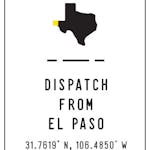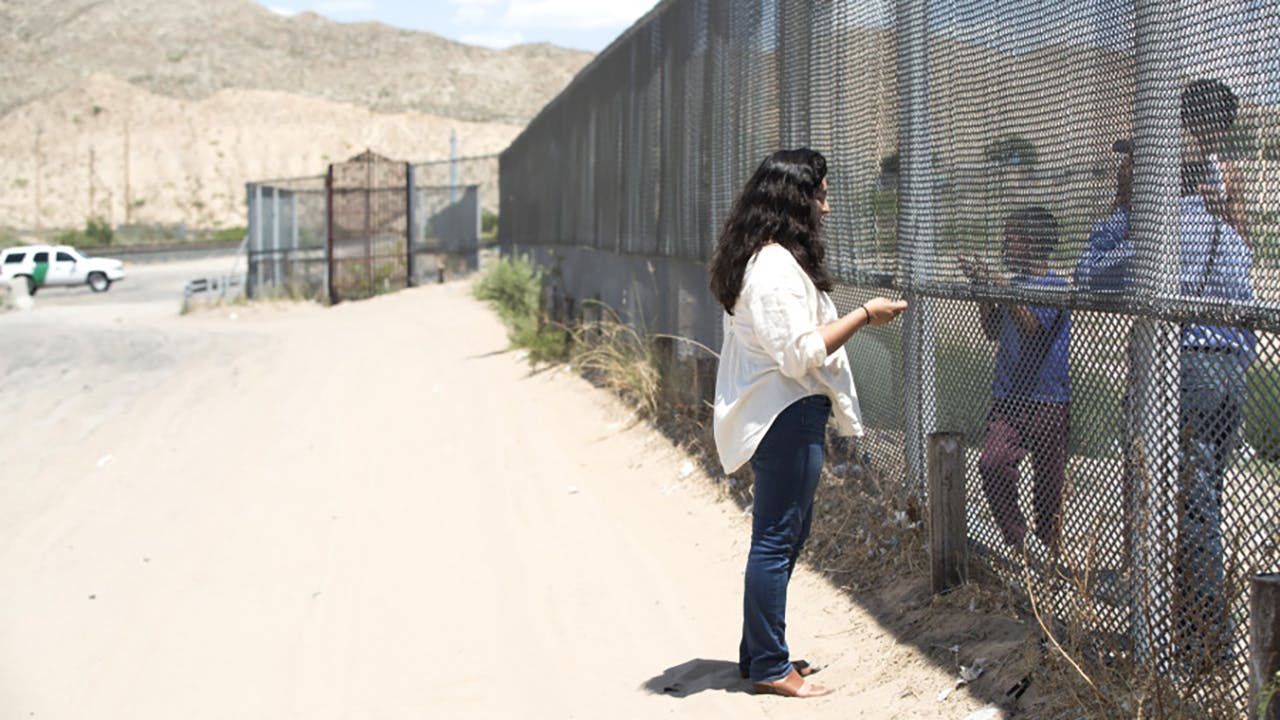 Sometimes, when driving on the west side of El Paso, you might take a sharp turn and, without meaning to, wind up in New Mexico. Until 2009, you could almost as easily cruise over a bridge and into Mexico, without a passport. The border here is not the kind of straight line that demarcates, say, the Panhandle; it’s more like a zigzag, a bureaucrat’s practical joke. Climbing in the Franklin Mountains one recent spring morning, overlooking that very boundary, Angie Reza Tures, her curly black hair whipping in the wind, motioned past the century plants and ocotillos and toward the view of distant neighborhoods over the rust-colored rocks ahead. Just which plots of land belonged to Texas was unclear. “We’re sitting on top of each other,” she said.
Sometimes, when driving on the west side of El Paso, you might take a sharp turn and, without meaning to, wind up in New Mexico. Until 2009, you could almost as easily cruise over a bridge and into Mexico, without a passport. The border here is not the kind of straight line that demarcates, say, the Panhandle; it’s more like a zigzag, a bureaucrat’s practical joke. Climbing in the Franklin Mountains one recent spring morning, overlooking that very boundary, Angie Reza Tures, her curly black hair whipping in the wind, motioned past the century plants and ocotillos and toward the view of distant neighborhoods over the rust-colored rocks ahead. Just which plots of land belonged to Texas was unclear. “We’re sitting on top of each other,” she said.
The 36-year-old filmmaker, who grew up in El Paso, has long given thought to the nature of that divide. She can appreciate the beauty of the natural barriers between the two countries—the mountains, the Rio Grande—and also the complexity of the man-made lines that are imposed on a bicultural population that has so many close historical ties. She left her city after high school to attend the University of San Francisco and eventually fell into film, but she knew she needed to move back to Texas to write and direct her first short narrative. She missed the sunsets that turned from bright gold into purple and the “very genuine, raw, vulnerable side to our culture in El Paso.” She wanted to make a film that conveyed the character of her home.
So in 2014, after returning to El Paso, she wrote a script, and a year later, she assembled a cast and crew and directed Memory Box, a story about a nineteen-year-old Mexican American woman named Julieta. Julieta is invisible to the film’s other characters, as she has recently, to her surprise, died; when she visits her Day of the Dead altar, she combs through personal photographs, reexperiencing the joys and regrets from her life. Ultimately, she attempts to reconcile with a brother she mistreated, whispering in his ear, “Love does not end in death.” Tures edited the film down to sixteen minutes, tinkering with the final touches. Then, last summer, when it was complete, came a question: Who would turn out to watch a movie this short?

It was the kind of moment that typically sparks desperate submissions to film festivals, and Tures did send the movie out for consideration. But she also had another idea: What if she got several female filmmakers from the border like herself to screen their films together? She put in a call to Jazmin Harvey, a director who had been working on a narrative short called Overland, about an undocumented woman from Mexico trying to make ends meet in the United States. Harvey liked the pitch. (She also welcomed the incentive, adding, “It was exciting for me to have a hard deadline.”) Then Tures called Laura Bustillos Jáquez. The director had completed the first segment of a documentary titled Undocumented Freedom, which follows a young man named Beto through his arrest and deportation. “I’ve lived in California, New York, and the Midwest, and those places were cool,” Jáquez said, “but I know that my work was recognized because I was telling stories from the border.” Showing the marginalized world she knew so well gave her purpose. She wanted in too.
By August of last year, Tures had created a showcase that featured the work of six filmmakers—she called the collective Femme Frontera—and booked El Paso’s Alamo Drafthouse theater for an initial preview for friends and family. Tickets to the screening sold out. The lights went down, and in addition to the works by Tures, Harvey, and Jáquez, the audience settled in to watch Iliana Sosa’s Child of the Desert, a dramatic short film about a military mother; Ilana Lapid’s La Catrina, a dreamy short narrative about a farmworker grieving her husband’s death; and Jennifer Lucero’s The Appleseed Project, a short documentary about female borderland musicians. Though Tures had selected the works for their variety—six stories and perspectives—it became clear in the Q&A with the filmmakers afterward that the audience seemed to appreciate them most as a lens on women’s issues.
But when the first public screening rolled around, just a few days after the November election, it was clear that Tures’s effort had taken on new meaning. With talk of a wall and deportations as serious possibilities—maybe probabilities—there was a sense of urgency among members of the audience. Attendees became emotional in the ensuing Q&A, voicing concerns that the presidential campaign had portrayed their physical reality and identity inaccurately—as a combat zone and as a threatening swath of humanity—and that people around the country apparently believed these descriptions. “We talked about people and presentation and grief,” Tures remembered. “People were asking us, ‘What are we going to do to start changing perceptions, to get these stories out there?’ ”
Ask someone in El Paso to recall an accurate representation of her town in a film or TV show, and she’ll usually have to think for a while. Sometimes what comes to mind, she’ll complain, are images of a tumbleweed rolling through an empty town, even though El Paso is a city of more than half a million people. One film that prompts an eye roll? The 2015 action movie Sicario. “In Sicario,” said Harvey, “all of Mexico is a monster—you can hear it in the sound design—and when they’re driving through El Paso, the immigrants are just quiet, feeble victims.” (She could not think of a film that showed El Paso honestly.)
Even rarer than a truthful portrayal of border life is a faithful depiction of its women, a problem that underscores not just the lack of Hispanic representation but also the paucity of female roles, both in front of and behind the camera. As headlines out of Hollywood have publicized, only 7 percent of the 250 top-grossing domestic films in 2016 were directed by women; in 2015, men took the leading role 83 percent of the time, and male characters were given twice as much speaking time, even though movies with female leads grossed an average of 15.8 percent more than those with a leading male. Reasons for the disparity abound, and Tures herself has theories. “Women—at least the ones I know—tend to be more collaborative,” she said. “I like working with women because we’re here to do a job, and the best idea on the table wins. Done.” She has noticed that not everyone appreciates this method. “There have been a few men I’ve worked with who see that behavior as indecisive. They think someone needs to be in charge, and they’re comfortable running with it. That has been my experience.”
To empower themselves, women directors have formed collectives—most notably Los Angeles’s Film Fatales, described on its website as a “diverse community of women filmmakers who meet regularly to mentor each other, share resources, collaborate on projects, and build a supportive environment in which to make their films.” Members of the group acknowledge that no one in the film industry is intentionally trying to keep women out; rather, the hurdle is executives’ reflexive instinct to hire people who remind them of their younger selves, a tendency that Film Fatales hopes, with its very existence, to disrupt. Tures admires the effort and is aware that chapters have been popping up across the globe (there are branches in San Francisco, New York, New Orleans, Toronto, Sydney, and Austin). She feels an affinity, of course.
But in her case, with Femme Frontera, the regional aspect of the group is as important as its members being recognized as women. Tures feels a calling to inhabit a broader identity, and unlike other places with film incentives or rich endowments, her city has a relatively small arts scene that is full of possibility. “I don’t feel that El Pasoans have any preconceptions of what El Paso art should be,” Tures said. “I don’t see anyone trying to copy anyone else. This leads to personal and professional growth and also gives us an ongoing challenge.” In the past five to ten years, natives who moved away have been returning: there’s Councilman Peter Svarzbein, for example, who was working as a photographer in New York City and came back to reestablish the city’s historic streetcar line between the University of Texas–El Paso campus and downtown; and Jim Ward, the former guitarist of At the Drive-In, who has opened a coffee shop and a music venue. “I think some of us just wanted to make art,” Tures said, “but what I’m noticing is that these people are becoming community leaders.” Now she is one of them.

There was a time when the members of Femme Frontera might have happily screened their films just regionally, when offering an audience an accurate portrayal of the border would have been satisfying enough. When Tures started the showcase, after all, she did not see it as a statement but as a celebration of home. That purpose has since changed: she wants as many viewers around the country to see the area as it truly is, with borderland residents as central characters in their own movies. In its first year, the Femme Frontera showcase will have screened in California, Texas, and South Carolina—in a church, two schools, several independent theater houses, and as part of a film festival. “Since the election,” Tures said, “the Femme Frontera has become a mission.”
Now the six directors, who meet on a monthly basis, have gone from organizing one showcase to planning for their group’s future. They have filed for status as a nonprofit, and after they receive that designation, they hope to organize more screenings and create more community engagement. In order to generate ideas among filmmakers, Tures plans to ask local authors to submit unpublished short stories. She is hoping to kick off a new showcase in August, featuring a different roster of directors. And when they go on tour, she hopes they can set up screenings in smaller towns where border culture is unfamiliar and, Tures said, “where stereotypes of our culture thrive.”
A long-term goal is perhaps the most crucial. Recognizing that they’ll eventually run out of filmmakers to tap for the showcases, the group, which sees itself evolving as more directors become involved, has been discussing plans for filmmaking workshops. Two of the current directors already supplement their income with teaching jobs: Lapid is an assistant professor at New Mexico State University, where she teaches film, and Tures teaches workshops during the school year and over summer break to kids on the south side of El Paso. Ideally, Tures wants to include some of the student films in the showcases, conceding, “It’s something that’s going to take a few years to build.”
Still, advances in technology are leveling the playing field for borderland students, opening up a world that would have been inaccessible in the past, when the cost of filming was so prohibitive that anyone without massive funding was out of luck. This summer, Tures is teaching three classes on filmmaking using smart devices, and students will be writing stories, storyboarding, shooting, editing, and distributing entirely on smartphones. She’ll show them how to reach an audience on YouTube and Vimeo or send the file to film festivals, which now accept smartphone submissions. (The film Tangerine, a narrative drama that premiered at Sundance in 2015, was shot on three iPhones and eventually released by Magnolia Pictures.)
As Tures is aware, in a world of democratized media, the cultural center is no longer geographical but online. While the voices that have been traditionally muted will never have the marketing power of Hollywood-backed projects, the filmmakers’ audiences are set to grow, especially in places where the mainstream has not found reach. Groups like Femme Frontera are forming the pipeline from which those stories will flow. This is just the beginning. “We’re not necessarily here to protest,” Tures said. “We’re not here to put down individuals we’ve worked with, put down men, put down people who believe differently from what we do. More than anything, it’s to say, ‘Our voices are important, and we’d like to share them with you. Here’s the truth of our experience.’ ”









